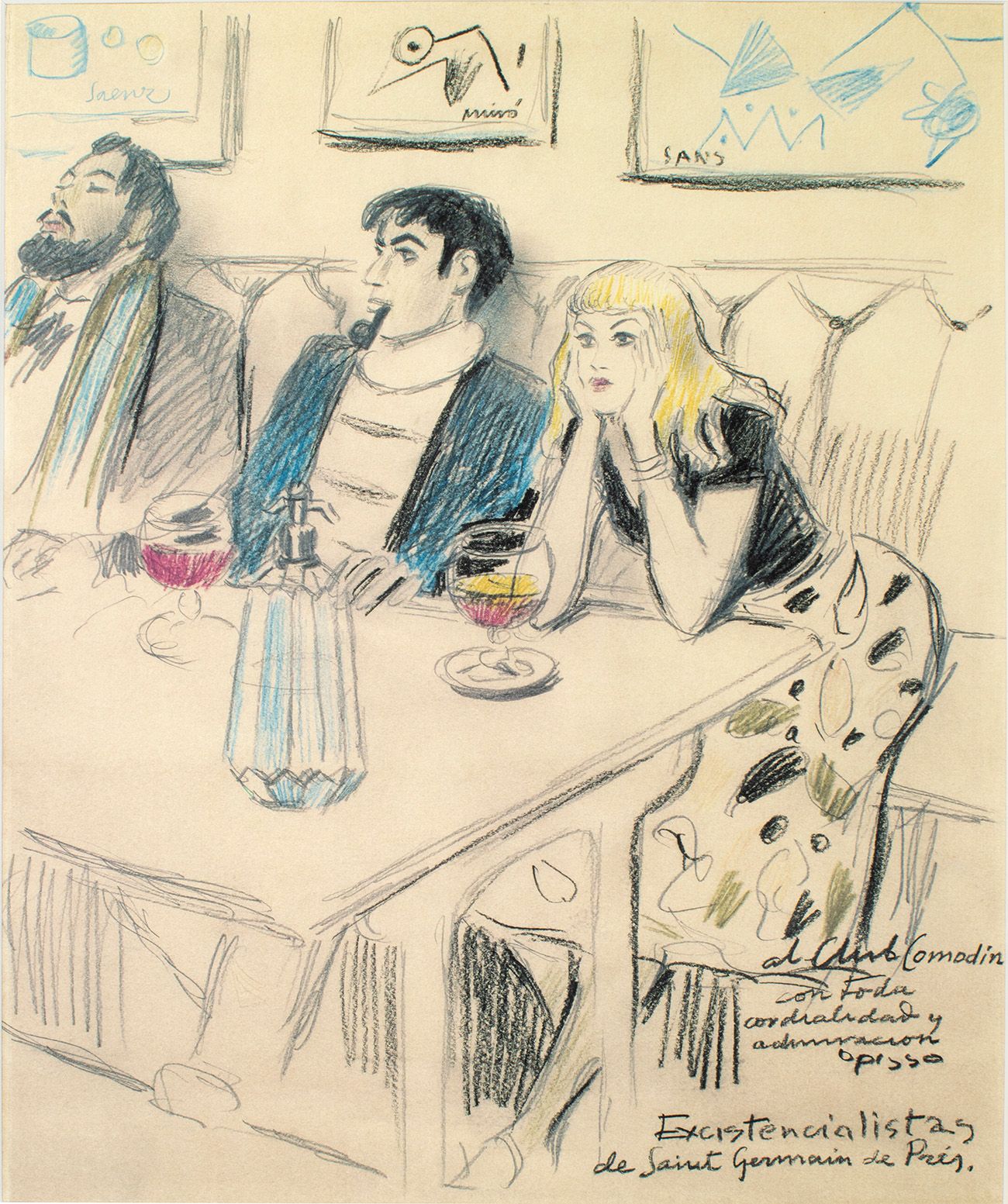Description
RICARDO OPISSO I SALA (Tarragona, 1880 - Barcelona, 1966). "Existentialists of Saint Germain des Prés". Mixed media on paper. Signed, titled and dedicated to the "Club Comodin" in the lower right corner. Size: 48 x 39 cm; 70,5 x 61 cm (frame). With his characteristic ingenuity for the recreation of bohemian interiors and curious characters, Opisso reproduces here the atmosphere of the group of existentialists in the Parisian district of Saint Germain des Prés. A blonde, a pipe smoker and a third member of the group who has drunk too much absinthe are seated at a table under paintings by Miró and Sainz. The drawing is dedicated to the Club Comodín de Ajedrez. Opisso was a painter, draughtsman and cartoonist. In his youth he participated in Barcelona's modernist environment, and in fact in 1894 he began to work as an apprentice with Antoni Gaudí on the works of the Sagrada Família. Two years later, backed by the architect, he became a member of the Círculo Artístico de Sant Lluc, with whom he would later exhibit at the Sala Parés. He was linked to the group Els Quatre Gats, together with Ramon Casas, Manuel Hugué, Isidre Nonell and Pablo Picasso, among others. In 1901 he made a trip to Paris, where Picasso and Hugué were already there. He worked as an illustrator in publications such as "Cu-cut!" and "L'Esquella de la Torratxa", signing drawings aimed at political satire, in a style close to art nouveau. In 1907 he took part in the Fine Arts Exhibition in Barcelona and was awarded a third-class medal. Due to the dictatorship of Miguel Primo de Rivera, Opisso abandoned political satire and his drawings moved towards genre themes, specialising in popular scenes. His works from this period are characterised by the presentation of motley crowds of people in popular Barcelona settings. After exhibiting several times in succession at the Sala Parés, he held his first solo exhibition in 1935 at the Syra galleries in Barcelona. During the post-war period he continued to exhibit in various galleries in Barcelona, and reaped considerable success with both critics and the public. In 1953 he received recognition from his native city at the 4th Tarragona Art Fair. During his early years, in addition to his surname, Opisso also used to sign his work with an "O" for Opisso, which contains the "R" of his name. Most of his work is kept in the Opisso Museum in Barcelona, but it is also present in the National Art Museum of Catalonia and the Museum of Modern and Contemporary Art in Strasbourg. In terms of exhibitions, the one held at the Thyssen-Bornemisza Museum in 2004 under the title "Catalan Painting, from Naturalism to Noucentisme", in which his work "Carnival" was exhibited, is particularly noteworthy. He has also had anthological exhibitions at the Saló del Tinell (1979), the Palau de la Virreina (1980), the Barcelona International Boat Show (1973), the Fundació La Caixa (1988, 2004, 2008) and the Caixa Tarragona (2003).
25
RICARDO OPISSO I SALA (Tarragona, 1880 - Barcelona, 1966). "Existentialists of Saint Germain des Prés". Mixed media on paper. Signed, titled and dedicated to the "Club Comodin" in the lower right corner. Size: 48 x 39 cm; 70,5 x 61 cm (frame). With his characteristic ingenuity for the recreation of bohemian interiors and curious characters, Opisso reproduces here the atmosphere of the group of existentialists in the Parisian district of Saint Germain des Prés. A blonde, a pipe smoker and a third member of the group who has drunk too much absinthe are seated at a table under paintings by Miró and Sainz. The drawing is dedicated to the Club Comodín de Ajedrez. Opisso was a painter, draughtsman and cartoonist. In his youth he participated in Barcelona's modernist environment, and in fact in 1894 he began to work as an apprentice with Antoni Gaudí on the works of the Sagrada Família. Two years later, backed by the architect, he became a member of the Círculo Artístico de Sant Lluc, with whom he would later exhibit at the Sala Parés. He was linked to the group Els Quatre Gats, together with Ramon Casas, Manuel Hugué, Isidre Nonell and Pablo Picasso, among others. In 1901 he made a trip to Paris, where Picasso and Hugué were already there. He worked as an illustrator in publications such as "Cu-cut!" and "L'Esquella de la Torratxa", signing drawings aimed at political satire, in a style close to art nouveau. In 1907 he took part in the Fine Arts Exhibition in Barcelona and was awarded a third-class medal. Due to the dictatorship of Miguel Primo de Rivera, Opisso abandoned political satire and his drawings moved towards genre themes, specialising in popular scenes. His works from this period are characterised by the presentation of motley crowds of people in popular Barcelona settings. After exhibiting several times in succession at the Sala Parés, he held his first solo exhibition in 1935 at the Syra galleries in Barcelona. During the post-war period he continued to exhibit in various galleries in Barcelona, and reaped considerable success with both critics and the public. In 1953 he received recognition from his native city at the 4th Tarragona Art Fair. During his early years, in addition to his surname, Opisso also used to sign his work with an "O" for Opisso, which contains the "R" of his name. Most of his work is kept in the Opisso Museum in Barcelona, but it is also present in the National Art Museum of Catalonia and the Museum of Modern and Contemporary Art in Strasbourg. In terms of exhibitions, the one held at the Thyssen-Bornemisza Museum in 2004 under the title "Catalan Painting, from Naturalism to Noucentisme", in which his work "Carnival" was exhibited, is particularly noteworthy. He has also had anthological exhibitions at the Saló del Tinell (1979), the Palau de la Virreina (1980), the Barcelona International Boat Show (1973), the Fundació La Caixa (1988, 2004, 2008) and the Caixa Tarragona (2003).
